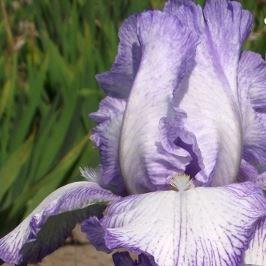
Iris x germanica 'Queen Dorothy'
Bearded Iris 'Queen Dorothy' (Tall)
Sporting grey-green pointed straplike leaves growing from a rhizome, which also produces flowers in a wide range of colours. The flowers have 3 falls (outer petals), and 3 standards (inner upright petals). Bearded irises are so called because the falls have soft hairs down the middle. 'Queen Dorothy, has flowers with white standards with a violet edge, and white falls with a violet edge. The beard is yellow, with a white tip
Contributed by @Puddings_pies
-
Full sun to partial shade
-
Occasional watering
-
Full Frost Hardy: 5F (-15°C)
-
Moist and free draining
Common name
Bearded Iris 'Queen Dorothy' (Tall)
Latin name
Iris x germanica 'Queen Dorothy'
type
Rhizome
family
Iridaceae
ph
6.1 - 8.1 Acid - Neutral
Plant & bloom calendar
-
Best time to plant
-
When the plant will bloom
full grown dimensions
 0.30 M
0.75 M
0.30 M
0.75 M
Iris x germanica 'Queen Dorothy'
Sporting grey-green pointed straplike leaves growing from a rhizome, which also produces flowers in a wide range of colours. The flowers have 3 falls (outer petals), and 3 standards (inner upright petals). Bearded irises are so called because the falls have soft hairs down the middle. 'Queen Dorothy, has flowers with white standards with a violet edge, and white falls with a violet edge. The beard is yellow, with a white tip
Propagating by division
From Early Autumn TO Mid Autumn
Irises should be divided each year after they have flowered, and the flower stems are dying. Divide by splitting each plant with a spade, leaving at least half of the plant in the ground, and then cut back the dying foliage and stems. Lastly, top-dress with bone-meal
Planting
From Late Summer TO Early Autumn
Ideally the Iris plant would need to be planted in a sunny spot so that it can receive at least six hours of sun a day as well as being planted in well drained but moist soil. They do well near water but should be at least 6 inches above water level. Plant with part of the rhizome exposed, as "baking" in late Summer sun will help flowering in Spring. Avoid hoeing around the base of the plants as the roots are near the surface and easily damaged. Do not mulch, as this can block light, and create damp that can rot the rhizome.
Flowering
From Early Spring TO Early Summer
Most bearded irises flower in Spring to early Summer, but some tall bearded varieties are remontant (ie have a second flowering period) in late Summer.








